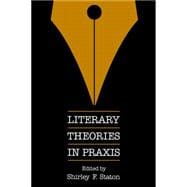
Note: Supplemental materials are not guaranteed with Rental or Used book purchases.
Purchase Benefits
Looking to rent a book? Rent Literary Theories in Praxis [ISBN: 9780812212341] for the semester, quarter, and short term or search our site for other textbooks by Staton, Shirley F.. Renting a textbook can save you up to 90% from the cost of buying.
| Introduction Pre-Text, Con-Text, and Sub-Text | p. 1 |
| New Criticism | p. 12 |
| Ecstasy: Dickinson's "My Life Had Stood -- a Loaded Gun -- " | p. 14 |
| Yeats's "Sailing to Byzantium" | p. 18 |
| The Rhyme Structure of the Byzantium Poems | p. 22 |
| Interpretation "The Birthmark" | p. 33 |
| Hawthorne's "The Birthmark": Science as Religion | p. 36 |
| The Shadow's Shadow: the Motif of the Double in Edgar Allan Poe's "The Purloined Letter" | p. 43 |
| Interpretation "A Rose for Emily" | p. 54 |
| Flannery O'Connor's "Revelation" | p. 58 |
| Phenomenological Criticism | p. 62 |
| Poe's Detective Tales | p. 64 |
| A Woman -- White: Emily Dickinson's Yarn of Pearl | p. 70 |
| Hawthorne, Heidegger, and the Holy: the Uses of Literature | p. 75 |
| The Parables of Flannery O'Connor | p. 90 |
| Archetypal and Genre Criticism | p. 97 |
| Emily Dickinson and the Deerslayer | p. 99 |
| The Archetypes of Literature Northrop Frye | p. 111 |
| Flannery O'Connor and the Catholic Grotesque | p. 124 |
| Structuralist-Semiotic Criticism | p. 133 |
| Sign, Structure, and Self-Reference in W. B. Yeats's "Sailing to Byzantium" | p. 135 |
| William Faulkner's "A Rose for Emily" | p. 155 |
| What Novels Can Do That Films Can't (and Vice Versa) | p. 160 |
| Decoding Papa: "A Very Short Story" as Work and Text | p. 171 |
| Striptease | p. 180 |
| Subculture the Meaning of Style | p. 183 |
| Sociological Criticism: Historical, Marxist, Feminist | p. 196 |
| The Text, the Poem, and the Problem of Historical Method | p. 203 |
| Theatre for Pleasure or Theatre for Instruction | p. 216 |
| Power and Law in Hawthorne's Fictions Eric Mottram | p. 222 |
| Ideology and Literary Form: W. B. Yeats | p. 233 |
| The Cinema After Babel: Language, Difference, Power | p. 235 |
| Vesuvius at Home: the Power of Emily Dickinson | p. 248 |
| Women Beware Science: "The Birthmark" | p. 261 |
| A Rose for "A Rose for Emily" | p. 270 |
| Psychoanalytic Criticism | p. 279 |
| "The Purloined Letter" | p. 281 |
| Fiction and the Unconscious: "The Birthmark" | p. 284 |
| Fantasy and Defense in Faulkner's "A Rose for Emily" | p. 295 |
| A Psychoanalytic Study: "Sailing to Byzantium" | p. 308 |
| Yeats and "Sailing to Byzantium" | p. 313 |
| Seminar on "The Purloined Letter" | p. 321 |
| Reader-Response Criticism | p. 351 |
| Norman N. Holland and "A Rose for Emily" -- Some Questions Concerning Psychoanalytic Criticism | p. 353 |
| How Readers Make Meaning | p. 357 |
| Styles of Reading | p. 367 |
| The Text and the Structure of Its Audience | p. 380 |
| Deconstructionist Criticism | p. 388 |
| Structure, Sign, and Play in the Discourse of the Human Sciences | p. 391 |
| The Frame of Reference: Poe, Lacan, Derrida | p. 410 |
| Humanist Criticism | p. 425 |
| The Practice of Theory | p. 426 |
| Selected Bibliography | p. 441 |
| Contributors | p. 453 |
| Index | p. 461 |
| Table of Contents provided by Publisher. All Rights Reserved. |
The New copy of this book will include any supplemental materials advertised. Please check the title of the book to determine if it should include any access cards, study guides, lab manuals, CDs, etc.
The Used, Rental and eBook copies of this book are not guaranteed to include any supplemental materials. Typically, only the book itself is included. This is true even if the title states it includes any access cards, study guides, lab manuals, CDs, etc.